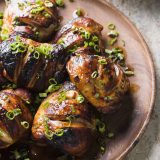Hanging under heat lamps across Hong Kong, large hunks of roasted meat fill shop windows with a spectrum of golden shades. The rich mahogany of roast duck (siu ngaap). The lacquered auburn of barbecue pork (char siu). The golden sheen of suckling pig (siu zyu).
All are iterations of siu mei, rotisserie meats that get their color—and deep flavor—from the umami-rich sauces they are cooked with. Among our favorite varieties is see yao gai, or soy sauce chicken—traditionally a whole bird coated with an amber glaze enriched with two kinds of soy sauce.
Unlike other siu mei, which are spit-roasted, see yao gai is cooked stovetop in a wok. This typically involves poaching small chickens—less than 2 pounds—in a mixture of sesame oil, dark and light soy sauces, and a rice wine called shaoxing. The sauce also can include brown sugar, ginger, garlic, clove, cinnamon, star anise, fennel seed, scallions and bay leaves, among other seasonings. The result has a rich, brown color and a flavor that’s salty, savory and slightly sweet, while the chicken itself is so tender it’s almost silky.
At Milk Street, we loved the richness of the sauce but knew preparing a whole chicken in a wok isn’t an option for most home cooks. So we decided to keep the flavors of the sauce—albeit with a pared-down ingredient list—and apply it to easier-to-cook chicken thighs.
We also borrowed a marinating technique we learned from Vietnamese cooking expert Andrea Nguyen. She deeply slashes chicken thighs before seasoning and roasting them. This creates more and deeper surface area for the seasonings.
As is sometimes done in traditional see yao gai, we cooked the sauce on its own first, then cooled it down and used it as a marinade. This deepens the flavors of the ginger and the 15 star anise pods. We also added ⅓ cup molasses, which simulated the viscosity of dark soy sauce while adding the caramelly sweetness of brown sugar.
We considered cooking the chicken in a skillet in an effort to mimic the wok, but found we got vastly better browning and caramel flavor—and far crispier skin—when we roasted it at 375°F. It also was easier and produced meat that was juicy, savory, succulent and a good match of the flavors of Hong Kong.




